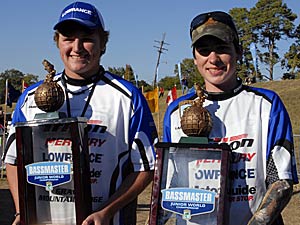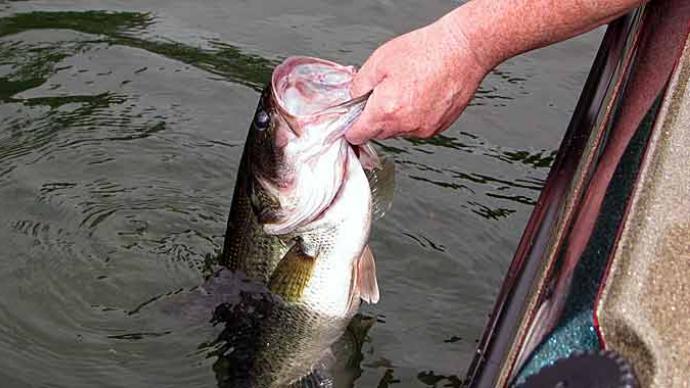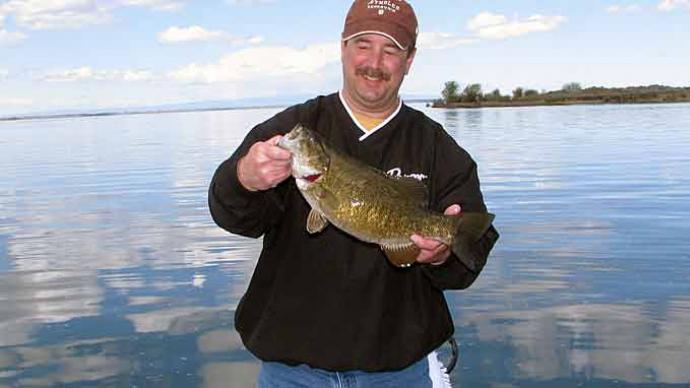
"Ninety percent of the bass caught are caught by ten percent of the anglers" - Dean Stroman. Unfortunately, there is much truth in Dean's quote. If 10 percent of the anglers do, in fact catch 90 percent of all of the bass that are caught, what do they know that the other 90 percent don't know and how would an angler move from the 90 percent group to the 10 percent group?
Although moving to the group catching all the fish requires some work, it is a much shorter trip than most anglers would guess.
We must first realize that most of our overt actions are guided by the force of habit. After performing the same tasks day in and day out, they become second nature and receive little thought after they are learned. For example, we usually drive the same route to and from work each day and only think a little about the directions. Likewise, many anglers fish the same way they drive to work. They do not think much about the "directions."
To move into the 10 percent group that we often hear about, it is necessary to examine the techniques that we use during our fishing trip and see if there are habits that we need to change.
The following few tips are designed to help you accomplish the two primary objectives of bass fishing: first, locate the fish and then catch the fish when you have located them.
Understanding Largemouth Bass
Although largemouth bass can be elusive and challenging for even the most knowledgeable angler to catch, they follow patterns based on the existing conditions. Before arriving at the lake, the educated angler has a good idea of the conditions they can expect to encounter, and most can even tell you how aggressive the bass will be.
A limited number of conditions affect their behavior, and you must be familiar with the most common of those conditions.
A change in existing weather patterns is undoubtedly the most common condition that the angler has to deal with. First, you usually have four different seasons of weather changes to deal with, and each one will cause bass to relocate to a different water level or area to seek the most comfortable water temperature available. Although 20 percent of the bass stay shallow throughout the year, winter weather usually cools the water and drives the bass to deeper water. After the first freeze of the year, bass instinctively know that cold weather is on its way and usually move to the breaklines in water deeper than 15 feet. Since all lakes have different depths, there are no standard definitions of "deep water." Although in most southern lakes, water deeper than 20 feet can be considered deep.
As the water temperature approaches 55 degrees, bass know that the warm-up signals that spring is arriving. Therefore, they will move to staging areas to prepare for the spawn. A staging area is usually a breakline with cover in the eight to 15-foot area. As the water temperature approaches 65 degrees, the females move to the nest and begin the spawn.
After the spawn, the bass will usually move back to the breaklines in the 10- to 15-foot area. During the nighttime and early mornings, they often move to shallow waters to feed and then return to the mid-depth areas when the sun and boat traffic drive them deeper. During this time of the year, the topwater bite is excellent early in the morning in shallow-water areas.
The bass are driven back to deeper water as the summer heat intensifies. Although they might be in the same areas where they spent the winter months, they tend to be more cover oriented.
Another condition that the angler must deal with is the type and size of baitfish that is available for the bass to feed on. This can affect the lure's size, type, and color to tempt the bass to strike. It is always a good rule to "match the hatch."
Lure color selection should be made based on the time of the year and the existing weather conditions. Springtime lure colors should be red, oranges, and chartreuse to match the baitfishes that are themselves spawning. Shad colors and silver are usually good colors throughout the year.
It is also important to realize that wind, clouds, and available sunlight can affect the light that the bass find necessary to distinguish colors. For example, black and blue colors are excellent nighttime and low-light lures because the bass can better see the silhouette of the lure. Another worthy quote from Dean Stroman is, "bright days, bright colors - dark days, dark colors."
Although numerous other conditions will affect largemouth bass, such as heavy boat traffic, cold fronts, turnover, turbid water, etc., the above information should give you some idea of where to begin your search. Although the information on other conditions can be obtained from various sources, BassResource.com has published various articles on dealing with adverse conditions.
Understanding your equipment is another essential trait that the 10 percent always possesses.
Most anglers seldom ever study a topographical map of the lake they will fish. As a result, many anglers fail to realize the importance of understanding breaklines and cover. Yet, a detailed topographical map can be the most helpful piece of equipment available when trying to locate a productive place to catch fish.
A breakline can be defined as a change in the underwater structure. A breakline can be a submerged roadbed, grassline, fence line, or merely a shape increase or decrease in the bottom, such as that caused by a creek bed.
Bass will usually use these breaklines as pathways when changing locations. When suspended, they will usually suspend over a breakline.
Cover is anything that the bass can use to relate to. The most common cover is usually a submerged stump or tree, but it can also be grass, docks, bridge pilings, etc. Bass, by their very nature, prey on their food. In other words, they hide in the cover and ambush the baitfish. Therefore, Bass look for cover located on, or very near, the breaklines.
A depth finder is another piece of equipment that is often under-utilized and misunderstood. Anglers commonly use the depth finder to determine the depth of water in which they are fishing. With proper training, the angler can determine the firmness of the bottom, structure, and cover likely to hold bass. In addition, most can determine if the fish they are watching on the depth finder is likely to be bass or some other type of fish.
Bottom firmness can be determined by the width of the grey or black portion of the depth finder picture that represents the bottom. Most brands show the bottom as a gray line. However, a few models depict it as a black line.
Shad are usually shown as large "balls" that are not attached to the bottom of the lake. The balls are usually gray in the middle, with a dark ring around the ball. It is not unusual to see more than one ball at a time on the depth finder.
It is essential to realize that since bass are structure and cover oriented, the fish you observed on the depth finder that are not related to or hiding in cover or structure are, in all likelihood, not bass.
Since the bass' eyesight will allow them to see in all directions except down, when the depth finder shows "balls" of shad with fish arches located directly beneath them, they are probably feeding bass.
Successful anglers always take care of their gear. While it is not necessary to spend a large amount of money to purchase a quality rod and reel that will function as needed, it is necessary to perform routine maintenance.
Reels should be wiped down after each trip and receive a complete cleaning at least once a year.
Rods should be inspected regularly for broken guides and signs of wear that could indicate it is time for repair or replacement. Also, if you leave your rods leaning against a wall for an extended period, chances are you will end up with a rod with a nice bow in it on your first trip to the lake after a long winter.
It is common for professional anglers to replace the line on their reels weekly. Unfortunately, many sport anglers fail to realize the importance of quality line and will often fish the entire year without replacing the line.
Without the proper line, the odds of a bass striking a lure are significantly reduced. Depending on the water conditions, bass usually have excellent vision underwater. If the bass can see the line, chances are they are not going to strike the lure.
A good rule to follow is that if the angler can see the line underwater, the bass can also see the line. Therefore, the safest line color to use is green or clear. Since braided line is denser, it is always easier for the fish to see. If you are fishing with braided line, there are green markers available that allow you to color the line.
A few helpful tips that will enable you to pick the best line for the conditions are:
- Use the lightest line possible for the conditions.
- Match the line color to the water conditions. The line color or diameter is not as crucial at nighttime or during low-light conditions. In high visibility conditions, the wrong line can result in a day without a strike
- Make sure the reel is full of line. For the reel to operate as designed, the spool must be full. It is possible to cast farther, control, and retrieve the lure at the correct speed with a full spool.
- Change your line regularly. It is also advisable to purchase your line at a sporting goods store that sells enough so that the line is rotated regularly. It is not uncommon to purchase line that is already weak from age.
The most common trait that the 10 percent of the anglers who are busy catching fish have is that they plan their trip beforehand. It is helpful to know where you are going before you get there.
The chances of a successful fishing trip are much greater if, before leaving for the lake, you are familiar with what weather pattern you can expect (even if it is bad, you can adjust your techniques) and know the types of lures that offer the best opportunity for strikes, and identify specific locations that you feel will produce bass. It is essential to realize that just because a location does not produce bass, it might not be a bad location. The location may be specifically a morning or afternoon spot. Try the location throughout the day.
Although many more tips would be helpful, these are some of the most basic and most ignored tips. As was mentioned previously, it takes patience to change old habits. Therefore, before your next trip, take a little time and plan your trip before leaving for the lake. It is the first step to a great trip.
I have received numerous calls and emails from interested readers who have questions or comments about my articles. It has been an absolute pleasure to hear from you, and I look forward to hearing from anyone with a comment or question.




